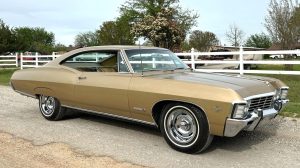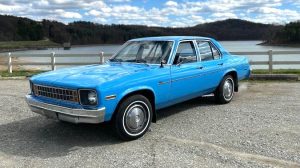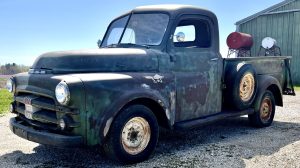If you haven’t already noticed, air-cooled German classics are currently hot items. While most people are hunting for Porsches, their VW siblings are great affordable alternatives. If you want something that looks more sporty than a Beetle, then a Karmann Ghia might be the car for you. This example, being offered here on Barn Finds, was disassembled for paint and never completed. It looks to be solid and complete. If you’d love to have it, it’s located in Buena Park, California with a $4,000 asking price.
Looking this Karmann Ghia over, we don’t see any of the rust issues typically found on these cars. While they feature the same drivetrain and chassis as the Beetle, the body was manufactured by Karmann and featured welded on fenders rather than bolt-on units found on the Bug. The more elaborate manufacturing process made for a beautiful car but means fixing rusty fenders is considerably more difficult. When buying one of these, you want to find the most solid example possible.
We don’t see any signs of rust, but you’ll want to inspect the floors and main structure to be sure. While the body is uniquely Karmann Ghia, the floor pan, chassis, and drivetrain are all taken from the Beetle, so you can easily get replacement parts. The interior, on the other hand, is unique to the Karmann. Don’t worry though, you can buy a complete interior restoration kit for under $1k. If you need a new engine, no worries there either. A complete engine can be had for $2k or less. The seller states that it was running and driving when it was taken apart for paint though. They also state that they drained the fuel system at the time that it was parked. Hopefully, that means with a new battery, a fluid change, and some fresh fuel it will be up and running again.
Volkswagen built over 21 million Beetles, which makes the 445k Karmann Ghias that were built seem downright rare. That’s still a ton of cars, but you really don’t see these as often as their Bug siblings. This one needs work, but it appears to be a great project. Personally, we would focus on making it a runner, then worry about addressing the cosmetic issues as time and funds become available. It actually has a cool look to it as is, but really deserves a nice paint job. If you’d love to give this VW a new home, be sure to contact the seller and make them an offer!















Primer notwithsanding (get it?) Bring a magnet. Could be a nice Ghia as Josh says, these had such a rust problem in the NE I haven’t seen one in years. Look it over good–for a cleaner car, go west young man! Good luck and stay safe.
Cheers
GPC
Yes, bring a magnet. Ghias are notorious for rust. Check above the headlights, the base of the A-pillars, the rockers & quarters, and even the corners of the engine cover & bonnet. Being a Cali car, it’s probably nowhere near bad, like a car from the northeast.
Floors, rockers, and headlight openings all tend to rust out on these. You also need to check out the nose, the design of these cars almost guarantee they got punched, rarely do you find one with without damage. That being said, these are nice cars, I had a 69 convert, it was a nice tight driving car, zero engine mods, and for some reason, women loved it, needless to say I drove it often….
We’ve had a few. Being a SoCal car, it should be fairly solid, however, Ghias are known for rot, especially here in the rust belt, and changing panels is not for the faint of heart. I’d check above the headlights, the base of the A-pillars, rockers & quarters. Also look for cracks above the rear wheel arches. Hoping she’s solid, and good luck!
How involved is it to ship an in-opp car and a collection of parts? Will a transport company do that?
https://www.uship.com/ship/
I’ve used “uship” which are independent shippers (ie..a guy with a pickup and trailer) to move some inop cars and parts around. Most “transport companies” won’t touch them as they like to move their loads around.
Bought one of these when I was stationed in Germany back in the early 70s. Did a lot of touring all around Europe in it. Was a great little car for the narrow roads. Not a lot of power, but keep it off the autobahn and it was powerful enough.
The reason why the Karmann-built Volkswagens (these as well as the Corvair-looking 1500 model based on the type 3 (a relative of mine had one of those for many years but mostly in storage as it rusted at the sight of water), which never made it to US shores) rusted far worse than the other rear engine Volkswagens is that the Karmann factory at the time didn´t have strong enough stamping machines to be able to use normal quality sheet metal. Therefore, they used softer sheet metal which had quite a lot of sulphur in it progressing rust at a much higher level when moist got to it. This is also the case with early Porsche 911 (and the 4-cyl 912) with bodies pressed by Karmann, but Porsche resolved the problem by having the later bodies galvanized. The first run of 911´s was pressed by some other body plant which unfortunatly slipped my memory, but these cars despite lacking galvanization are said to be far better rustproof than the following Karmann bodies – the reason for the change of supplier has been said to be cheaper production, but adding the extra galvanizing process makes me wonder about that. By the way, the evolved version of the flat four that was presented in the VW 411/412 (type 4) cars and Bay window microbuses and VW-Porsche 914 (successor of the VW Karmann-Ghia 1500) was developed by Porsche for Volkswagen but tolerances and materials are more to Volkswagens than Porsches standards. A very reliable engine though, especially the 1.8 litre. I´ve put a lot of miles on those in the microbuses and their pickup brethrens at work – propably the no 1 small truck in Northern Europe back in their day and you can still see many T80´s in use in small business and as campers. Wish i could say the same for the final version used in the 80´s microbuses and pickups, commonly known as the Wasserboxer engine which are prone to blow their heads off because of hydralizing sooner or later. Back to the Karmann-Ghia, i´d love to put the 1.8 engine in the back of one of those, best of two eras and few would notice the difference if the fan housing would be altered to the old upright kind.
Wonder what that is in the garage under all that stuff?
For a moment, that straight-on rear photo made me think the rear bumper was a big solid unit from a postwar Chrysler product, Checker cab or some such. Then I realized the light was hitting it in such a way to obscure the overrider above the main bumper.
This is the car Porsche should have built.
I had an awesome one, a ’64 convertible. At the time I has a couple of old trashed Speedsters, one with a VW engine, and the Ghia was close to the Speedster in driving pleasure and handling.
Took that thing to Hawaii with me, which was probably a death sentence, thinking about it today. I sold it over there to finance the trip.
4k is decent for this baby. In So Cal, a nice running one with decent paint is 15-25k. So there’s plenty of upside.